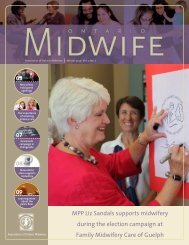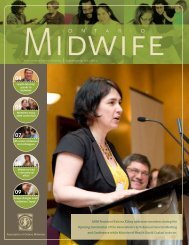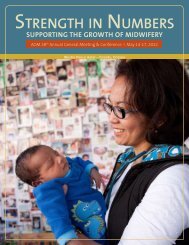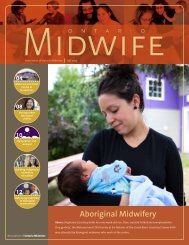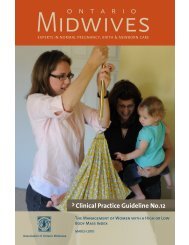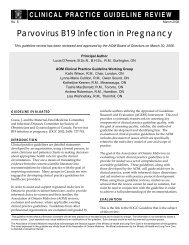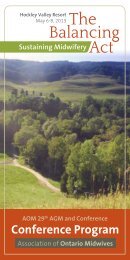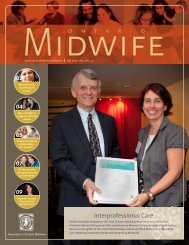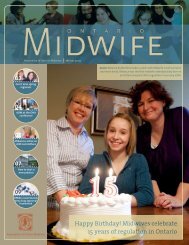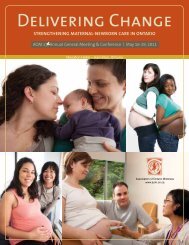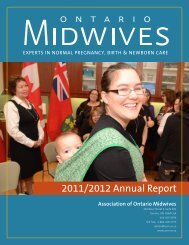Emerging Crisis, Emerging Solutions - Association of Ontario Midwives
Emerging Crisis, Emerging Solutions - Association of Ontario Midwives
Emerging Crisis, Emerging Solutions - Association of Ontario Midwives
Create successful ePaper yourself
Turn your PDF publications into a flip-book with our unique Google optimized e-Paper software.
June 1, 2006Ms. Jane PepinoChair<strong>Ontario</strong> Women’s Health Council101 Bloor St. West5 th floorToronto ON M5S 2Z7Dear Ms. Pepino:Reference: <strong>Ontario</strong> Maternity Care Expert PanelThe 15 members <strong>of</strong> the <strong>Ontario</strong> Maternity Care Expert Panel have great pleasure insubmitting our report Maternity Care in <strong>Ontario</strong> 2006: <strong>Emerging</strong> <strong>Crisis</strong>, <strong>Emerging</strong><strong>Solutions</strong>. Over the last 18 months the panel has worked diligently with staff to provide acomprehensive overview <strong>of</strong> the present state <strong>of</strong> maternity care in the province, identifyboth what is working well and where problems with access and quality exist. We haveengaged a wide variety <strong>of</strong> representative groups, policy makers and consumers, and maderecommendations for a coordinated and realistic maternity care strategy for <strong>Ontario</strong>.The document is divided into three major sections 1) the present state <strong>of</strong> maternity care in<strong>Ontario</strong>, 2) vision and principles <strong>of</strong> maternity care in <strong>Ontario</strong>, and 3) how do we get to aprovince-wide strategy that integrates all sectors to provide access for childbearingwomen across <strong>Ontario</strong>. This strategy emphasizes the education and skills <strong>of</strong> the rightprovider at the right time, in an effective and efficient manner that is reviewed regularlyby the Ministry <strong>of</strong> Health and Long-term Care, with reports to all key programs. Ourrecommendations align with the new ministry vision <strong>of</strong> stewardship and address how aprovincial maternity care strategy would work with Local Health Integration Networksand other partners.We have examined current peer-reviewed and other literature, completed a hospitalsurvey from over 100 hospital sites across the province, conducted focus groups inThunder Bay, Guelph, Owen Sound, Hamilton, and Toronto, provided a forum throughthe OWHC web site to ascertain women’s views, and liaised with other provincialmaternity care projects – Babies Can’t Wait and Integrated Maternity Care for Rural andRemote Communities - and federally with the Multi-disciplinary Collaborative PrimaryMaternity Care Project (MCP 2 ). We have also had many opportunities to seek input andpresent our interim findings to the pr<strong>of</strong>essional, regulatory and educational bodiesinvolved in maternity care in <strong>Ontario</strong>. This process has assisted us to identify importantissues and engage in developing recommendations which to date reflect broad agreementon the part <strong>of</strong> the major stakeholders.We would like to commend the Ministry <strong>of</strong> Health and Long-term Care and the <strong>Ontario</strong>Women’s Health Council for their support and cooperation with our requests forinformation on a number <strong>of</strong> issues including: numbers <strong>of</strong> maternity care providers,
funding mechanisms, explanations <strong>of</strong> policies and procedures, and numbers <strong>of</strong> births andintervention data. Everyone involved treated the panel with utmost respect and this hasled to the development <strong>of</strong> a multiple-layered recommendation document. In particularOMCEP members would like to thank Wendy Katherine, OMCEP Project Manager, forher outstanding contribution, organization, patience, and dedication during the last 18months. There is no doubt in our minds that this project would not have been possiblewithout her guidance and assistance.The experience <strong>of</strong> our panel and our stakeholder consultations has demonstrated thatinter-pr<strong>of</strong>essional collaboration, and leadership by government, will lead to manysolutions for present maternity care issues. We feel confident in our recommendedapproach which identifies a plan for, and priorities <strong>of</strong>, a future ministry-led Office <strong>of</strong>Maternal and Newborn Health or similar mechanism to be the hub <strong>of</strong> this importantongoing work in association with policy-makers, health care providers and childbearingwomen.Yours sincerely,Renato Natale, HBSc, MD, FRCSC, FACOG Jennifer Medves, RN, PhDTerry O’Driscoll, MD, CCFP, FCFPVicki Van Wagner, RM, MES, PhD(c)
MEMBERS THE ONTARIO MATERNITY-CARE EXPERT PANEL (OMCEP)Anne Biringer, MD, CCFP, FCFPRosana Pellizzari, MD, MSc, CCFP, FRCPCSharon Lynn Dore, RN, PhDJudy Rogers, RM, MAElana Johnson, RMJanet Rush, RN, BScN, MHSc, PhDCatherine MacKinnon, MD, FRCSCAnn Sprague, RN, PhDSheila McIntyre, BA, MA, PhDVicki Van Wagner, RM, MES, PhD(c)Jennifer Medves, RN, PhDRory Windrim, BSc, MD, FRCSCRenato Natale, HBSc, MD, FRCSC, FACOGMary Woodman, RN(EC), BScN, MPATerry O’Driscoll, MD, CCFP, FCFP
TABLE OF CONTENTSONTARIO MATERNITY CARE EXPERT PANEL MEMBERS.............................. 4DEFINITION OF COLLABORATION......................................................................... 7ACKNOWLEDGEMENTS ............................................................................................. 8EXECUTIVE SUMMARY .............................................................................................. 9MATERNITY CARE SERVICES IN ONTARIO ....................................................................... 9THE MATERNITY CARE SERVICES OPPORTUNITY .......................................................... 10SUMMARY OF OMCEP RECOMMENDATIONS:................................................................ 13MATERNITY CARE NOW .......................................................................................... 15THE CONTINUUM OF MATERNITY CARE SERVICES ........................................................ 17LOW-VOLUME MATERNITY CARE – A SAFE MODEL OF CARE ...................................... 21MATERNITY CARE PROVIDERS ...................................................................................... 24NURSES AND MATERNITY CARE .................................................................................... 24MIDWIVES AND MATERNITY CARE................................................................................ 28INTERVENTIONS IN THE BIRTH PROCESS ........................................................................ 35MATERNITY CARE DATA ............................................................................................... 39A SYSTEM UNDER STRESS.............................................................................................. 41A VISION FOR MATERNITY CARE IN ONTARIO ............................................... 43GUIDING PRINCIPLES FOR MATERNITY CARE IN ONTARIO ...................... 44WOMAN AND FAMILY-CENTRED CARE PRINCIPLES....................................................... 44PRINCIPLES OF SERVICE PROVISION............................................................................... 47PRINCIPLES OF PROVINCIAL STEWARDSHIP AND COORDINATION .................................. 48A MATERNITY CARE STRATEGY FOR ONTARIO............................................. 57WORKING WITH LOCAL HEALTH INTEGRATION NETWORKS.......................................... 60BUILDING CAPACITY BASED ON REGIONAL MATERNITY CARE NETWORKS .................. 60A FOCUS FOR ADVICE – THE MATERNITY CARE PROVINCIAL ADVISORY COMMITTEE.. 61PROVINCIAL PLANNING FOR MATERNITY CARE ............................................................ 63LHINS AND MATERNITY CARE PLANNING REGIONS ..................................................... 63PRIORITIES FOR AN ONTARIO MATERNITY CARE STRATEGY ......................................... 65HUMAN RESOURCE DEVELOPMENT AND EDUCATIONAL STRATEGIES ........................... 69INTEGRATION AND COLLECTION OF DATA..................................................................... 69SYSTEM EVALUATION.................................................................................................... 70HUMAN RESOURCES PLANNING AND EDUCATION FOR MATERNITYCARE IN ONTARIO...................................................................................................... 75PLANNING FOR INTRAPARTUM CARE PROVIDERS .......................................................... 77PLANNING FOR OTHER PROVIDER GROUPS ESSENTIAL TO MATERNITY CARE............... 80OMCEP PROJECTIONS................................................................................................... 84REGIONAL PLANNING AND THE DISTRIBUTION OF CARE PROVIDERS............................. 86SUPPORTS FOR RECRUITMENT AND RETENTION............................................................. 885
ONGOING RESEARCH FOR HEALTH HUMAN RESOURCES PLANNING.............................. 89CONCLUSIONS................................................................................................................ 89EDUCATION FOR MATERNITY CARE PROVIDERS: SUSTAINING ONTARIO’S MATERNITYCARE SYSTEM................................................................................................................ 91INTER-PROFESSIONAL EDUCATION NETWORK ............................................................... 91EARLY EXPOSURE TO MATERNITY CARE AND TO NORMAL BIRTH................................ 92RECRUITMENT ............................................................................................................... 92CLINICAL PLACEMENTS ................................................................................................. 94MAXIMIZING CAPACITY/PROGRAM EXPANSION ............................................................ 96MODELS OF MATERNITY CARE FOR ONTARIO............................................. 104MODEL DESIGN............................................................................................................ 108CLINICAL CARE ........................................................................................................... 109CONTRIBUTION OF PUBLIC HEALTH............................................................................. 111ESTABLISHED SINGLE-PROFESSIONAL MODELS OF CARE ............................................ 112MODELS FOR 24-HOUR CALL ...................................................................................... 113COMMUNITY AND INSTITUTION CHARACTERISTICS ..................................................... 114PROVINCIAL CO-ORDINATION OF TRANSPORTATION AND EVACUATION IN ONTARIO.. 117MULTI-PROFESSIONAL MATERNITY CARE MODELS..................................................... 117ISSUES FOR RURAL/REMOTE MATERNITY CARE.......................................................... 119ANAESTHESIA SERVICES FOR MATERNITY CARE MODELS IN ONTARIO....................... 120INTER-PROFESSIONAL MODELS OF MATERNITY CARE................................................. 122CHOICE OF BIRTHPLACE .............................................................................................. 124CENTRES OF EXCELLENCE FOR NORMAL BIRTH .......................................................... 127REGULATION, LIABILITY PROTECTION AND PAYMENT:.......................... 132THE STRUCTURES OF THE MATERNITY CARE SYSTEM................................................. 132REGULATING MATERNITY CARE.................................................................................. 132LIABILITY PROTECTION ISSUES.................................................................................... 135FUNDING MODELS FOR MATERNITY CARE .................................................................. 137APPENDICES............................................................................................................... 144APPENDIX A – RECOMMENDATIONS ............................................................................ 144APPENDIX B – BIBLIOGRAPHY ..................................................................................... 164APPENDIX C - MODELS CHART OF MATERNITY CARE ................................................. 187APPENDIX D - ANAESTHESIA REPORT.......................................................................... 205APPENDIX E - EVALUATION PLAN ............................................................................... 258APPENDIX F - HOSPITAL SURVEY SUMMARY............................................................... 270APPENDIX G – METHODS, FOCUS GROUPS, KEY INFORMANTS AND STAKEHOLDERS .. 284APPENDIX H - PRIMARY HEALTH CARE TRANSITION FUND PROJECTS ........................ 291APPENDIX I - OMCEP MATERNITY CARE SURVEILLANCE REPORT............................. 296APPENDIX J - GLOSSARY.............................................................................................. 332APPENDIX K - SUBMISSIONS TO OMCEP..................................................................... 3606
Definition <strong>of</strong> Collaborationcollă´bor|āteAs adapted from the Oxford Canadian Dictionary(1) Work jointly, esp. at literary or artistic production(2) Operate traitorously with the enemyFrom the outset <strong>of</strong> our work, ‘collaboration’ was to be a key theme for the <strong>Ontario</strong>Maternity Care Expert Panel. We certainly planned for it to typify our internal workingrelationships and we felt certain that as a Panel we would be researching both teampractices and collaborative care practices as potential optimal maternity care models for<strong>Ontario</strong>’s future. We discovered that collaboration at both levels was an interesting,surprising, and even challenging process.The panel took great satisfaction in considering the nature <strong>of</strong> collaboration in a settingthat involved so many diverse groups: education programs for medicine, midwifery andnursing; midwives (both aboriginal and registered); physicians (including specialties <strong>of</strong>anaesthesia, family practice, obstetrics and paediatrics/neonatology); pr<strong>of</strong>essionalassociations; providers <strong>of</strong> pr<strong>of</strong>essional liability protection; registered nurses (includingregistered practical nurses, public health nurses and nurse practitioners); regulatorybodies; staff from the Ministry <strong>of</strong> Health and Long-Term Care and maternity careagencies and women using maternity care services.“One <strong>of</strong> the successes <strong>of</strong> the panel is that we have created a place for these discussions.People are now looking for the opinions <strong>of</strong> other pr<strong>of</strong>essions.” – OMCEP Panel Member
AcknowledgementsThe <strong>Ontario</strong> Maternity Care Expert Panel developed this report with the help <strong>of</strong>numerous individuals:Writers:Jean BaconTheresa DobkoLissa DonnerLiane GinsburgWendy KatherineJennifer MedvesRenato NataleTerry O’DriscollJudy RogersVicki Van WagnerResearch Support:Sarah ChambersRoseanne HickeySarah KnoxChristine Kurtz-LandySarah Latha-ElliotColleen McNameeElissa PressAdditional Ministry Staff:Michael BarrettJudy FiddesSue MatthewsKaren ParsonsVena Persaud8
MATERNITY CARE IN ONTARIO 2006:EMERGING CRISIS, EMERGING SOLUTIONSExecutive SummaryMaternity Care Services in <strong>Ontario</strong>The <strong>Ontario</strong> Women’s Health Council created the <strong>Ontario</strong> Maternity Care Expert Panel inOctober <strong>of</strong> 2004 to address concerns about the trends <strong>of</strong> decreasing accessibility <strong>of</strong>maternity care services a , changing trends in service provision and long term sustainability<strong>of</strong> maternity care in <strong>Ontario</strong>. Maternity care services are “the foundation for thesubsequent health <strong>of</strong> mothers, babies and their families”. 1The scope <strong>of</strong> maternity care services in <strong>Ontario</strong> includes approximately 40% <strong>of</strong> all livebirths in Canada 2 with the number <strong>of</strong> births expected to rise within the next 20 years fromapproximately 131,000 births annually in 2003 to 157,000 in 2024. 3 Maternity care is aleading reason for hospital admission. 4 Maternity care services touch virtually everyfamily in every region <strong>of</strong> <strong>Ontario</strong>. The success <strong>of</strong> these services – from pre-conceptioneducation to prenatal support to post-natal care – has lifelong implications for the health<strong>of</strong> neonates as they become adults, for women, and for the lives <strong>of</strong> their families andcommunities. 5In <strong>Ontario</strong>, the impact <strong>of</strong> these services on the health status <strong>of</strong> our population, the livesand functioning <strong>of</strong> families, the long-term costs <strong>of</strong> health services in terms <strong>of</strong> issues andthe overall economic and social health <strong>of</strong> our society is not routinely measured orevaluated. <strong>Ontario</strong>’s health system spends over one billion dollars a year b on maternitycare services, yet there have been no province-wide policies or regular reports on access,distribution or effectiveness <strong>of</strong> these services. There is a general lack <strong>of</strong> populationhealth policy for the system as a whole, with current policies concentrating on services byindividual provider groups only.Other provinces, including British Columbia, Alberta, Nova Scotia and Prince EdwardIsland have established provincial strategies to provide a framework for the coordinationand delivery <strong>of</strong> maternity care 6-9 and several provinces have commissioned recentreviews <strong>of</strong> their maternity care systems in response to evidence citing a maternity care‘crisis’. 10-12 The Society <strong>of</strong> Obstetricians and Gynaecologists <strong>of</strong> Canada, among otheraOMCEP uses the terms “maternity care” and “maternal-newborn health services” within this report. Bothterms refer to the continuum <strong>of</strong> care provided to a woman and her newborn(s) from pre-pregnancy to abouttwo months after birth.b This estimate was developed using case costing information to extrapolate the amount spent by hospitalson maternity care. Added to this estimate were budgets for public health maternal and newborn programs,midwifery funding and liability insurance reimbursements for obstetricians, family physicians andmidwives. This estimate represents a partial costing only. Blended budgets and an absence <strong>of</strong> explicitreports for many relevant ministry programs prevented OMCEP from developing a comprehensiveinventory <strong>of</strong> maternal newborn health care expenditures.9
national maternity care stakeholders, has also characterized the current state <strong>of</strong> Canada’smaternity care health human resources as ‘in crisis’. 13The Maternity Care Services OpportunityThe <strong>Ontario</strong> Maternity Care Expert Panel believes <strong>Ontario</strong> has an optimum opportunitynow to provide the leadership necessary to transform this critical part <strong>of</strong> the province’shealth system to provide better and more accessible services to women and infants; toachieve enhanced health outcomes and to contribute to the overall health <strong>of</strong> our citizensand communities.The premise upon which this report is based is that the <strong>Ontario</strong> Ministry <strong>of</strong> Health mustassume that leadership role and work with other ministries to achieve a renewed vision <strong>of</strong>maternity care. We are calling for the establishment <strong>of</strong> the Office <strong>of</strong> Maternal andNewborn Health (OMNH) or equivalent mechanism– a Ministry mandated program withthe responsibility and authority for establishing and maintaining an overall provincialplan for maternity care services. The OMNH would ensure that the system will bemonitored and coordinated at the provincial level, adapting dynamically to the needs <strong>of</strong>local communities and working closely with Local Health Integration Networks, localand regional care providers, other stakeholders and with the women and families whorely on these services.The Guiding Principles for Maternity Care Services in <strong>Ontario</strong>In the Panel’s view, a framework for ongoing maternity care policy is urgently needed.We have developed a simple and encompassing vision to aid in the transformation <strong>of</strong><strong>Ontario</strong> maternity care services.Every woman in <strong>Ontario</strong> will have access to high quality, woman and familycentredmaternity care as close to home as possible.We believe that this vision will best be fulfilled if the actions <strong>of</strong> the Office <strong>of</strong> Maternaland Newborn Health and <strong>of</strong> all those engaged in the transformation <strong>of</strong> <strong>Ontario</strong>’smaternity care services are focused to develop a specific maternity care system based onthe following guiding principles:Woman and Family Centred Care• Care across the continuum <strong>of</strong> maternity and newborn care• Equitable access to “Care as Close to Home as Possible”• Pregnancy and birth as a normal physiological process• Regional coordination <strong>of</strong> services and access to high-risk care• Woman and family centred care including:10
• Empowerment and participation• Informed choice• Choice <strong>of</strong> birthplace• Quality care to diverse and vulnerable populations• Continuity <strong>of</strong> carePrinciples <strong>of</strong> Service Provision• Valuing maternity care providers• Collaboration – inter-pr<strong>of</strong>essional, respectful and seamless• Provider preparation, competence and confidencePrinciples <strong>of</strong> Stewardship and Coordination• Effective coordination <strong>of</strong> services• Maternity care as part <strong>of</strong> primary care• Alignment <strong>of</strong> the system with national and international determinants <strong>of</strong> health• Continuous evaluation and improvement to ensure quality and safety• Financial responsibility and accountabilityOverview <strong>of</strong> the ReportThis report describes both the approaches the Panel has taken to researching;understanding the current system, provincial needs and the directions in which we believe<strong>Ontario</strong> should be moving to fulfill our vision for maternity care in <strong>Ontario</strong>.It includes a detailed discussion <strong>of</strong> a variety <strong>of</strong> models <strong>of</strong> care that allow for improvedaccess and comprehensive care in a wide variety <strong>of</strong> settings. There are recommendationsfor the required changes in maternity care provider human resources to maintain asustainable system into the future. It also includes an overview <strong>of</strong> regulatory, liabilityand funding issues that will need review and modification on both a provincial andnational basis. Lastly it describes the need for, and a model for, provincial stewardshipincluding; planning, co-ordination, data collection and evaluation. Throughout the reportis the recognition that, in addition to health care providers, the women and families whoaccess services need to have their voices heard in concrete ways in all levels <strong>of</strong> planningand evaluation; from the planning <strong>of</strong> their own care to the planning for the models <strong>of</strong> caredelivery, in the education for the providers and in the strategic planning for the province.Throughout our deliberations and the preparation <strong>of</strong> this report, we have consulted widelywith stakeholders – including extensive involvement <strong>of</strong> women and women’srepresentatives, pr<strong>of</strong>essionals and those involved in the current health caretransformations to help ensure that the system that evolves from these initiatives willreflect our guiding principles and result in maternity care services that can make theoptimum contribution to the health <strong>of</strong> women, infants, families and the society as awhole.A partial list <strong>of</strong> the publications reviewed (Appendix B), the submissions received(Appendix K), the groups and individuals consulted and the conferences attendedthroughout the Panel’s work (Appendix G) can be found at the end <strong>of</strong> the report. The11
panel created an extensive library <strong>of</strong> bibliographic references which has become aninvaluable tool for the creation <strong>of</strong> this report and will hopefully continue to provide thebackbone for future developments in maternity care in <strong>Ontario</strong>.The Panel is grateful for all those who assisted in our deliberations, to the women whoshared their stories and to the dedicated pr<strong>of</strong>essionals who aspire to a vision <strong>of</strong> animproved maternity care system.12
Summary <strong>of</strong> OMCEP Recommendations:A complete list <strong>of</strong> OMCEP recommendations by theme is contained in Appendix AThe <strong>Ontario</strong> Maternity Care Expert Panel recommends that the Premier <strong>of</strong> <strong>Ontario</strong> directthe ministries <strong>of</strong> Health and Long-Term Care, Children and Youth Services, HealthPromotion, Training Colleges and Universities and Attorney General to work withpr<strong>of</strong>essional organizations, regulatory bodies and educational institutions to takeimmediate action to address the impending maternal-newborn care crisis and ensure thatwomen and families receive access to essential, high-quality, effective and sustainablematernity care services in <strong>Ontario</strong> by:1. Increasing the number <strong>of</strong> maternity care providers and declaring a moratorium onmaternity care program closures in communities that have sufficient health humanresources to maintain safe services.2. Immediately establishing an ongoing provincial maternity care program led byMinistry <strong>of</strong> Health and Long-Term Care and regional networks <strong>of</strong> care providers tobe responsible for:• Creating a sustainable maternal and newborn care plan for <strong>Ontario</strong> with fullfinancial responsibility and accountability;• Integration <strong>of</strong> that plan across ministries, all regions and services;• Alignment <strong>of</strong> the maternity care plan with the government’s transformationplan with maternity care as an integral part <strong>of</strong> primary care;• Ongoing performance measurement to ensure access to quality services.3. Incorporating women’s input into maternity care at all levels from informed decisionmakingabout their own care to local, regional and provincial service planning policy.4. Ensuring timely and equitable access to quality maternity care by committing to:• Primary maternity care delivered close to home;• Services that are responsive to the needs <strong>of</strong> diverse and vulnerable populations;• Woman and family-centred models <strong>of</strong> care;• Regionally coordinated access to high-risk care.5. Create and undertake public and pr<strong>of</strong>essional education campaigns to support asustainable maternity care system and promote pregnancy and birth as a normalphysiologic process with access to care for complications, as needed.6. Attract, support and retain maternity care providers by developing a system thatvalues and respects all provider groups, including midwives, nurses and physiciansthrough harmonization <strong>of</strong> regulation and liability mechanisms and creation <strong>of</strong>complementary funding schemes.7. Remove barriers to care and create structures that support:• The effective use <strong>of</strong> all care providers to their full scopes <strong>of</strong> practice;• Collaboration amongst pr<strong>of</strong>essionals;• Innovative inter-pr<strong>of</strong>essional models <strong>of</strong> education and clinical care foundedon evidence-based guidelines and practices.
1. Multi-disciplinary Collaborative Primary Maternity Care Project. Guidelines fordevelopment <strong>of</strong> a multi-disciplinary collaborative primary maternity care model. Ottawa;2006 Apr.2. Statistics Canada.Births, 2003. The Daily; 2005 Jul 12. Available from:http://www.statcan.ca3. Ministry <strong>of</strong> Finance Projections, 2004.4. Canadian Institute for Health Information. Giving birth in Canada: a regional pr<strong>of</strong>ile,2004.5. Mustard JF, McCain MN, Bertrand J. Changing beliefs to change policy: the earlyyears study. ISUMA 2000 Autumn;1(2):76-9.6. Alberta Perinatal Health Program. Website: http://www.aphp.ca7. British Columbia Reproductive Care Program. Website: http://www.rcp.gov.bc.ca8. Reproductive Care Program <strong>of</strong> Nova Scotia. Website: http://rcp.nshealth.ca9. Prince Edward Island Reproductive Health Programme. Website:http://www.gov.pe.ca/infopei/onelisting.php3?number=2061610. A report <strong>of</strong> Manitoba's working group on maternal/newborn services [in press]. 2005May.11. Maternity Care Enhancement Project. Supporting local collaborative models forsustainable maternity care in British Columbia. 2004 Dec.12. Nova Scotia Department <strong>of</strong> Health. Report <strong>of</strong> the Primary Maternity Care WorkingGroup. Halifax; 2005 Jun.13. Lalonde AB. Access to maternity care [editorial]. JOGC 2005 May;27(5):445-6.



